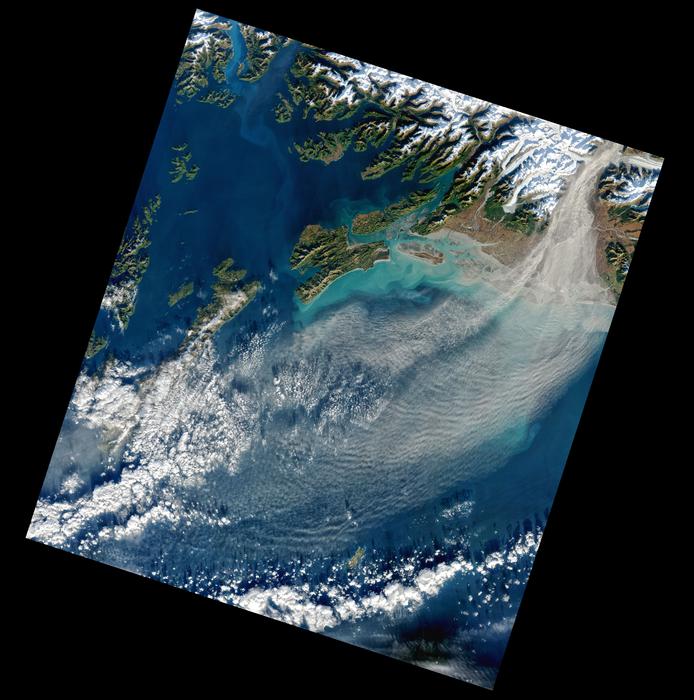Giant dust storms in the Gulf of Alaska can last for many days and send tonnes of fine sediment or silt into the atmosphere, and it is having an impact on the global climate system, say scientists.

Credit: You must credit: USGS/NASA Landsat
Giant dust storms in the Gulf of Alaska can last for many days and send tonnes of fine sediment or silt into the atmosphere, and it is having an impact on the global climate system, say scientists.
The storms are so extensive they can be seen by satellites orbiting the Earth. An image captured by the Landsat satellite in 2020 shows dust blowing out of the valley and over Alaska’s south coast.
Exactly how the dust may be influencing the global climate system is not yet clear, although new research from the University of Leeds and the National Centre for Atmospheric Science suggests the effect is bigger than previously thought.
How ice forms in clouds
At a low enough temperature, the silt – microscopic fragments of rock, minerals and vegetation – act as ice nucleating particles, which encourage the formation of ice crystals in clouds.
Whether ice formation in clouds will add to global warming or help cool the planet depends on how much ice they contain, how many ice nucleating particles are present and the nature of those particles.
In a paper published today -(Wednesday, Aug 16) – in the journal Science Advances, the research team argue that more research is needed to understand the role that dust plays in the complex global climate system.
Research has focussed on Saharan dust
Previous research has focused on dust particles whipped up into the atmosphere from storms in the Sahara and across Africa and Asia, all of which are at mid to low latitudes and involve dust generated from desert environments.
The researchers at Leeds took a different approach and decided to look at a high-latitude source of dust. They analysed dust coming from the Copper River Valley on the south coast of Alaska, which extends for more than 275 miles. The river is estimated to transport 70 million tonnes of glacial sediment every year.
During periods of low water – in the summer and autumn – the silt is picked up by winds and carried over hundreds of miles across north America, reaching altitudes where it can cause ice formation in clouds.
Unlike the dust from Sahara, however, dust particles from the Copper Valley River will contain a greater volume of biological material, deposited by the rich vegetation and wildlife that live in the region.
Ice formation in clouds
Dust particles in the atmosphere are important agents in ice formation.
In the absence of dust, water in clouds can remain in liquid form even though temperatures may be well below freezing.
Professor Benjamin Murray, an Atmospheric Scientist in the School of Earth and Environment at Leeds who supervised the study, said: “Only a small fraction of the dust particles in the atmosphere has the capacity to nucleate ice and we are only just starting to understand their sources and global distribution.
“Whether a cloud becomes more or less reflective of sunlight depends on how much ice is in them, so we need to be able to understand and quantify the various sources of ice-nucleating particles around the globe.
“At present, climate models tend not to represent these high-latitude sources of dust, but our work indicates that we need to.”
During the investigation, Sarah Barr and Bethany Wyld, doctoral researchers in the School of Earth and Environment at Leeds, collected samples during dust storms. The material was later analysed in the laboratory and compared to the types of dust particles that originate from desert environments.
They found that the particles from Alaska were more effective in forming ice than the dust that comes from the Sahara, driven by the presence of microscopic fragments of biogenic substances, particles that would have been produced by living organisms.
In contrast, particles of a mineral called potassium feldspar are believed to be the main ice nucleating agent in dust from the Sahara and locations in mid to low-level latitudes.
Ms Barr, the lead author of the paper, said: “We knew that deserts like the Sahara are very important at supplying ice-nucleating particles to the atmosphere, but this paper shows that river deltas like the Copper River Valley are also very important.
“Huge quantities of dust are emitted from places like the Copper River, and we need to understand these emissions to improve our climate models.”
The paper, Southern Alaska as a source of atmospheric mineral dust and ice-nucleating particles, is published in Science Advances and can be downloaded from the following URL when the embargo lifts https://doi.org/10.1126/sciadv.adg3708
END
Journal
Science Advances
DOI
10.1126/sciadv.adg3708
Method of Research
Experimental study
Subject of Research
Not applicable
Article Publication Date
16-Aug-2023




